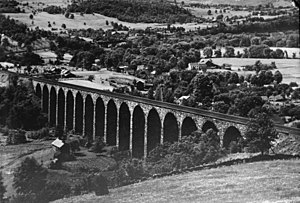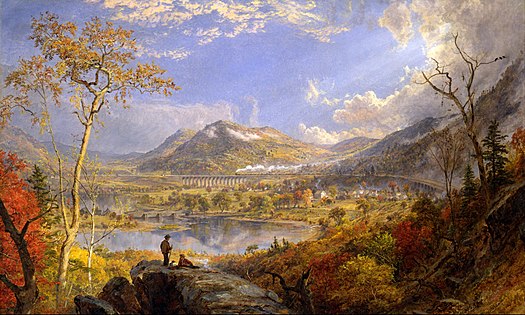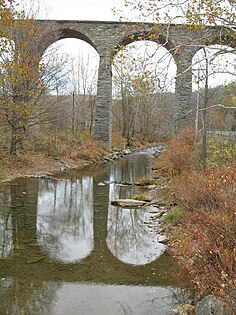| Revision as of 15:51, 29 November 2020 editRisk Engineer (talk | contribs)Extended confirmed users4,316 edits Changed coordinates to better place point on bridge← Previous edit | Latest revision as of 12:14, 11 August 2024 edit undo70.29.65.159 (talk) →19th century | ||
| (25 intermediate revisions by 15 users not shown) | |||
| Line 1: | Line 1: | ||
| {{Short description|Bridge in Lanesboro, Pennsylvania}} | |||
| {{Infobox Bridge | {{Infobox Bridge | ||
| |bridge_name=Starrucca Viaduct | |bridge_name = Starrucca Viaduct | ||
| |image=HAER-Starrucca 1.jpg | |image = HAER-Starrucca 1.jpg | ||
| |image_size= | |image_size = 300px | ||
| |caption=A 1920 picture of the Starrucca Viaduct |
|caption = A 1920 picture of the Starrucca Viaduct | ||
| |official_name= | |official_name = | ||
| |crosses=] | |crosses = ] | ||
| |carries=Two tracks of the ] | |carries = Two tracks of the ] | ||
| |locale=] | |locale = ] | ||
| |design=Stone ] | |design = Stone ] | ||
| |mainspan=Seventeen spans of {{convert|50|ft|m}} | |mainspan = Seventeen spans of {{convert|50|ft|m}} | ||
| |length={{convert|1040|ft|m}} | |length = {{convert|1040|ft|m}} | ||
| |width=Two tracks | |width = Two tracks | ||
| |below={{convert|100|ft|m}} | |below = {{convert|100|ft|m}} | ||
| |open=1848 | |open = 1848 | ||
| |maint=] | |maint = ] | ||
| |id= | |id = | ||
| |coordinates={{coord|41. |
|coordinates = {{coord|41.9632|N|75.5833|W|display=inline,title}} | ||
| |lat= | |lat = | ||
| |long= | |long = | ||
| |clearance= | |clearance = | ||
| |traffic= | |traffic = | ||
| |closed= | |closed = | ||
| |toll= | |toll = | ||
| |map_cue= | |map_cue = | ||
| |map_image= | |map_image = | ||
| |map_text= | |map_text = | ||
| |map_width= | |map_width = | ||
| }} | }} | ||
| '''Starrucca Viaduct''' is a stone ] that spans ] near ], in the |
'''Starrucca Viaduct''' is a stone ] that spans ] near ], in the United States. Completed in 1848 at a cost of $320,000 (equal to ${{formatnum:{{Inflation|US|320000|1848}}}} today), it was at the time the world's largest stone railway viaduct and was thought to be the most expensive railway bridge as well. Still in use, the viaduct is listed on the ] and is designated as a ]. | ||
| == |
==History== | ||
| ===19th century=== | |||
| The ] was designed by ] and ] and built in |
The ] was designed by ] and ] and built in 1847–48 by the ], of locally-quarried random ] ], except for three brick interior longitudinal ] walls and the concrete bases of the piers. This may have been the first structural use of concrete in American bridge construction.{{Citation needed|date=January 2021}} | ||
| It was built to solve an engineering problem posed by the wide valley of Starrucca Creek. The railroad considered building an ], but abandoned the idea as impractical. The Erie Railroad was well-financed by British investors |
It was built to solve an engineering problem posed by the wide valley of Starrucca Creek. The railroad considered building an ], but abandoned the idea as impractical. The Erie Railroad was well-financed by British investors but, even with money available, most American contractors at the time were incapable of the task. Julius W. Adams, the superintending engineer of construction in the area, hired James P. Kirkwood, a civil engineer who had worked on the ]. Accounts differ as to whether Kirkwood worked on the bridge himself, or whether Adams was responsible for the plans with Kirkwood working as a subordinate. The lead stonemason, Thomas Heavey, an Irish immigrant from County Offaly, worked on other projects for Kirkwood, primarily in New England. It took 800 workers, each paid about $1 per day, equal to ${{formatnum:{{Inflation|US|1|1848|r=2}}}} today, to complete the bridge in a year. The ] for the bridge required more than half a million feet of cord and hewn timbers.{{Citation needed|date=January 2021}} | ||
| The original single ] track was replaced by two ] tracks in 1886. |
The original single ] track was replaced by two ] tracks in 1886. The roadbed deck under the tracks was reinforced with a layer of concrete in 1958.<ref name=HAERsurvey/> | ||
| The bridge has been in continual use for more than a century and a half. | |||
| ⚫ | |||
| ===20th century=== | |||
| The viaduct was designated as a ] by the ] in 1973 and was listed on the ] in 1975.<ref>{{cite book |last=Treese |first=Lorett |year=2003 |title=Railroads of Pennsylvania: Fragments of the Past in the Keystone Landscape |url=https://books.google.com/books?id=lMK3DAAAQBAJ&pg=PA173 |location=Mechanicsburg, Pennsylvania |publisher=Stackpole Books |page=173 |isbn=9780811743570 |access-date=25 September 2021}}</ref> | |||
| ===21st century=== | |||
| ⚫ | In 2005, the ] leased the portion of the line from ] to ] to the ], which operates it under the name ]. The only railroad currently using it is Delaware Otsego's ].{{Citation needed|date=April 2022}} | ||
| The viaduct is listed on the ] and is a ]. | |||
| <gallery mode="packed" heights="210px"> | <gallery mode="packed" heights="210px"> | ||
| Line 56: | Line 63: | ||
| {{reflist|refs= | {{reflist|refs= | ||
| <ref name=HAERsurvey> | <ref name=HAERsurvey> | ||
| {{cite web|title=HAER survey drawings (sheet 1 of 3)|url=https://www.loc.gov/pictures/item/pa1270.sheet.00001a/}} | {{cite web|title=HAER survey drawings (sheet 1 of 3)|website=] |url=https://www.loc.gov/pictures/item/pa1270.sheet.00001a/}} | ||
| {{cite web|title=HAER survey drawings (sheet 2 of 3)|url=https://www.loc.gov/pictures/item/pa1270.sheet.00002a/}} | {{cite web|title=HAER survey drawings (sheet 2 of 3)|website=] |url=https://www.loc.gov/pictures/item/pa1270.sheet.00002a/}} | ||
| {{cite web|title=HAER survey drawings (sheet 3 of 3)|url=https://www.loc.gov/pictures/item/pa1270.sheet.00003a/|publisher=US Library of Congress| |
{{cite web|title=HAER survey drawings (sheet 3 of 3)|url=https://www.loc.gov/pictures/item/pa1270.sheet.00003a/|publisher=US Library of Congress|access-date=29 January 2016}} | ||
| </ref> | </ref> | ||
| Line 66: | Line 73: | ||
| {{Refbegin}} | {{Refbegin}} | ||
| *{{HAER |survey=PA-6 |id=pa1270 |title=Erie Railway, Delaware Division, Bridge 189.46}} | *{{HAER |survey=PA-6 |id=pa1270 |title=Erie Railway, Delaware Division, Bridge 189.46}} | ||
| *{{Structurae|id=20001298|title=Starrucca Viaduct| |
*{{Structurae|id=20001298|title=Starrucca Viaduct|access-date=2006-06-16}} | ||
| *{{cite book|last=Plowden |first=David |title=Bridges: The Spans of North America |year=2002 |publisher=W. W. Norton |location=New York |isbn=9780393050561}} | *{{cite book|last=Plowden |first=David |title=Bridges: The Spans of North America |year=2002 |publisher=W. W. Norton |location=New York |isbn=9780393050561}} | ||
| *American Society of Civil Engineers, Reston, VA. Historic Civil Engineering Landmarks. Accessed |
*American Society of Civil Engineers, Reston, VA. Historic Civil Engineering Landmarks. Accessed 2022-01-26. | ||
| *{{cite journal|title=Erie has Largest Stone Bridge|journal=Erie Railroad Magazine|date=August 1939|pages=11|url= |
*{{cite journal|title=Erie has Largest Stone Bridge|journal=Erie Railroad Magazine|date=August 1939|pages=11|url=https://elmags.railfan.net/ERIE_Aug1939.pdf|access-date=2011-10-13}} | ||
| *{{cite journal | last = Brown | first = Jeff L. | title = Rock Solid: Stone Arch Bridges of the 1840s | journal = Civil Engineering | pages = 44–47 | publisher = American Society of Civil Engineers | location = Reston, VA | date = January 2014 | issn = 0885-7024 }} | *{{cite journal | last = Brown | first = Jeff L. | title = Rock Solid: Stone Arch Bridges of the 1840s | journal = Civil Engineering | pages = 44–47 | publisher = American Society of Civil Engineers | location = Reston, VA | date = January 2014 | issn = 0885-7024 }} | ||
| {{Refend}} | {{Refend}} | ||
| ==External links== | ==External links== | ||
| * at Susquehanna County, Pennsylvania's website | * at Susquehanna County, Pennsylvania's website | ||
| * at ASCE Civil Engineering Landmarks | * at ASCE Civil Engineering Landmarks | ||
| * at Bridges & Tunnels | * at Bridges & Tunnels | ||
| * at Literary & Cultural Heritage Map of PA | * at Literary & Cultural Heritage Map of PA | ||
| {{Commons category|Starrucca Viaduct}} | {{Commons category|Starrucca Viaduct}} | ||
| Line 86: | Line 93: | ||
| ] | ] | ||
| ] | ] | ||
| ] | |||
| ] | ] | ||
| ] | ] | ||
Latest revision as of 12:14, 11 August 2024
Bridge in Lanesboro, Pennsylvania| Starrucca Viaduct | |
|---|---|
 A 1920 picture of the Starrucca Viaduct A 1920 picture of the Starrucca Viaduct | |
| Coordinates | 41°57′48″N 75°35′00″W / 41.9632°N 75.5833°W / 41.9632; -75.5833 |
| Carries | Two tracks of the New York, Susquehanna and Western Railway |
| Crosses | Starrucca Creek |
| Locale | Lanesboro, Pennsylvania |
| Maintained by | New York, Susquehanna and Western Railway |
| Characteristics | |
| Design | Stone arch bridge |
| Total length | 1,040 feet (320 m) |
| Width | Two tracks |
| Longest span | Seventeen spans of 50 feet (15 m) |
| Clearance below | 100 feet (30 m) |
| History | |
| Opened | 1848 |
| Location | |
Starrucca Viaduct is a stone arch bridge that spans Starrucca Creek near Lanesboro, Pennsylvania, in the United States. Completed in 1848 at a cost of $320,000 (equal to $11,268,923 today), it was at the time the world's largest stone railway viaduct and was thought to be the most expensive railway bridge as well. Still in use, the viaduct is listed on the National Register of Historic Places and is designated as a National Historic Civil Engineering Landmark.
History
19th century
The viaduct was designed by Julius W. Adams and James P. Kirkwood and built in 1847–48 by the New York and Erie Railroad, of locally-quarried random ashlar bluestone, except for three brick interior longitudinal spandrel walls and the concrete bases of the piers. This may have been the first structural use of concrete in American bridge construction.
It was built to solve an engineering problem posed by the wide valley of Starrucca Creek. The railroad considered building an embankment, but abandoned the idea as impractical. The Erie Railroad was well-financed by British investors but, even with money available, most American contractors at the time were incapable of the task. Julius W. Adams, the superintending engineer of construction in the area, hired James P. Kirkwood, a civil engineer who had worked on the Long Island Rail Road. Accounts differ as to whether Kirkwood worked on the bridge himself, or whether Adams was responsible for the plans with Kirkwood working as a subordinate. The lead stonemason, Thomas Heavey, an Irish immigrant from County Offaly, worked on other projects for Kirkwood, primarily in New England. It took 800 workers, each paid about $1 per day, equal to $35.22 today, to complete the bridge in a year. The falsework for the bridge required more than half a million feet of cord and hewn timbers.
The original single broad gauge track was replaced by two standard gauge tracks in 1886. The roadbed deck under the tracks was reinforced with a layer of concrete in 1958.
The bridge has been in continual use for more than a century and a half.
20th century
The viaduct was designated as a National Historic Civil Engineering Landmark by the American Society of Civil Engineers in 1973 and was listed on the National Register of Historic Places in 1975.
21st century
In 2005, the Norfolk Southern Railway leased the portion of the line from Port Jervis to Binghamton, New York to the Delaware Otsego Corporation, which operates it under the name Central New York Railway. The only railroad currently using it is Delaware Otsego's New York, Susquehanna and Western Railway.
-
 Starruca Viaduct, Pennsylvania, 1865, by Jasper Francis Cropsey
Starruca Viaduct, Pennsylvania, 1865, by Jasper Francis Cropsey
-
 October 2009
October 2009
-
 October 2014
October 2014
See also
- List of bridges documented by the Historic American Engineering Record in Pennsylvania
- List of Erie Railroad structures documented by the Historic American Engineering Record
- List of Pennsylvania state historical markers in Susquehanna County
References
- "HAER survey drawings (sheet 1 of 3)". Library of Congress. "HAER survey drawings (sheet 2 of 3)". Library of Congress. "HAER survey drawings (sheet 3 of 3)". US Library of Congress. Retrieved 29 January 2016.
- Treese, Lorett (2003). Railroads of Pennsylvania: Fragments of the Past in the Keystone Landscape. Mechanicsburg, Pennsylvania: Stackpole Books. p. 173. ISBN 9780811743570. Retrieved 25 September 2021.
- Historic American Engineering Record (HAER) No. PA-6, "Erie Railway, Delaware Division, Bridge 189.46"
- Starrucca Viaduct at Structurae. Retrieved 2006-06-16.
- Plowden, David (2002). Bridges: The Spans of North America. New York: W. W. Norton. ISBN 9780393050561.
- American Society of Civil Engineers, Reston, VA. "Starrucca Viaduct." Historic Civil Engineering Landmarks. Accessed 2022-01-26.
- "Erie has Largest Stone Bridge" (PDF). Erie Railroad Magazine: 11. August 1939. Retrieved 2011-10-13.
- Brown, Jeff L. (January 2014). "Rock Solid: Stone Arch Bridges of the 1840s". Civil Engineering. Reston, VA: American Society of Civil Engineers: 44–47. ISSN 0885-7024.
External links
- Bridges to the Future at Susquehanna County, Pennsylvania's website
- Starrucca Viaduct at ASCE Civil Engineering Landmarks
- Starrucca Viaduct at Bridges & Tunnels
- Solid as a Rock: The Starrucca Viaduct at Literary & Cultural Heritage Map of PA
- Bridges completed in 1848
- Railroad bridges on the National Register of Historic Places in Pennsylvania
- Historic Civil Engineering Landmarks
- Viaducts in the United States
- Bridges in Susquehanna County, Pennsylvania
- Historic American Engineering Record in Pennsylvania
- Erie Railroad bridges
- National Register of Historic Places in Susquehanna County, Pennsylvania
- Stone arch bridges in the United States

